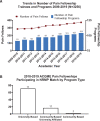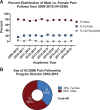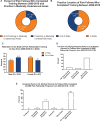Diversity of Pain Medicine Trainees and Faculty in the United States: A Cross-Sectional Analysis of Fellowship Training from 2009-2019
- PMID: 33502490
- PMCID: PMC8599803
- DOI: 10.1093/pm/pnab004
Diversity of Pain Medicine Trainees and Faculty in the United States: A Cross-Sectional Analysis of Fellowship Training from 2009-2019
Abstract
Objective: Diversity and equity in medicine remain pivotal to care delivery. Data analysis on sex and racial diversity of pain medicine fellowship trainees and faculty in the United States are scant. We sought to characterize demographic and retention patterns among pain medicine fellows and faculty, who represent the emerging chronic pain management workforce.
Design: cross-sectional retrospective analysis.
Method: We conducted an analysis of data from the American Association of Medical Colleges (AAMC) and the United States Accreditation Council on Graduate Medical Education (ACGME)-approved residency and fellowship training-programs for each year from 2009 through 2019, inclusively. We compared changes in sex, racial/ethnicity composition and retention rates of fellows and faculty in the United States by practice setting.
Results: From 2009 to 2019, there was a 14% increase in the number of ACGME pain fellowship programs. From 2009 to 2019, the ratio of men to women pain fellows ranged from 5:1 to 3.7:1. Compared with their self-identified White peers, Asian (OR 0.44; 95% CI: 0.34-0.58), Black (OR 0.46; 95% CI: 0.30-0.72), and Native American/Alaskan Native (OR 0.26; 95% CI: 0.08-0.80) identifying individuals had significantly lower odds of being a pain fellow, P < 0.05. There was no significant difference in female (OR = 0.4, 95% CI: 0.148-1.09) and Black (OR 0.36; 95% CI: 0.11-1.12) program-directors. Pain-fellow in-state retention was 53%.
Conclusions: The demographics of pain medicine training programs reflect a persistent male vs. female gap with underrepresentation of racial minorities. Further research is needed to elucidate reasons underlying these disparities.
Keywords: Diversity; Faculty; Fellows; Pain Medicine; Race; Sex.
© The Author(s) 2021. Published by Oxford University Press on behalf of the American Academy of Pain Medicine.All rights reserved. For permissions, please e-mail: journals.permissions@oup.com.
Figures




References
-
- Deville C, Hwang W-T, Burgos R, Chapman CH, Both S, Thomas CR.. Diversity in graduate medical education in the United States by race, ethnicity, and sex, 2012. JAMA Intern Med 2015;175(10):1706–8. - PubMed
-
- AAMC. More Women than Men Enrolled in U.S. Medical Schools in 2017. Available at: https://www.aamc.org/news-insights/press-releases/more-women-men-enrolle... (accessed June 29, 2020).
-
- March JA, Adams JL, Portela RC, Taylor SE, McManus JG.. Characteristics and diversity of ACGME accredited emergency medical services fellowship programs. Prehosp Emerg Care 2019;23(4):551–9. - PubMed
-
- Higgins MCSS, Hwang W-T, Richard C, et al.Underrepresentation of women and minorities in the United States IR Academic Physician Workforce. J Vasc Interv Radiol 2016;27(12):1837–44.e2. - PubMed
-
- Doshi TL, Richter HC, Salisu M, Samen C.. Representation of women in pain medicine fellowships in the United States, 2017–2018. Pain Med 2019;21(2):e62–7. - PubMed
Publication types
MeSH terms
Grants and funding
LinkOut - more resources
Full Text Sources
Other Literature Sources
Miscellaneous

